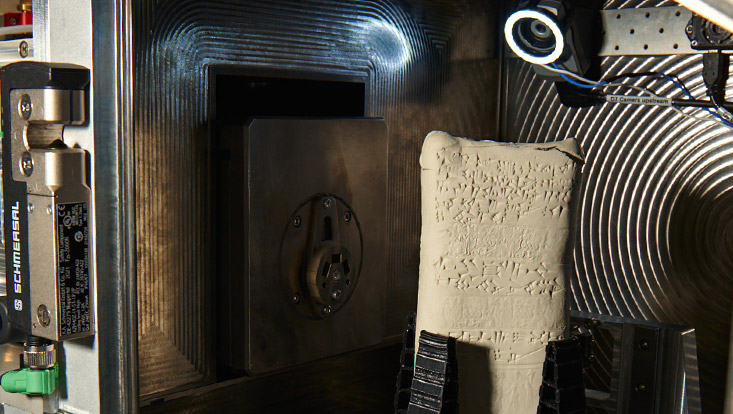24 January 2024
First use in the Louvre in ParisUsing the World’s First Mobile Computer Tomography Device to Decipher Hidden Texts

Photo: UHH/K.Helmholz
Cuneiform tablets from ancient Mesopotamia in the Middle East are the oldest written artifacts in the world. To protect the information written on them, in 3,000 BCE people began enclosing them in envelopes made of clay. Some of these were never opened, for example, if they never arrived at their intended destination, with the result that today, many museums around the world have sealed cuneiform tablets in their archives.
Now, researchers in the Cluster of Excellence Understanding Written Artefacts (UWA) at Universität Hamburg, and the Deutsches Elektronen-Synchrotron (DESY) have developed the world’s first computer tomography device that can read these sealed tablets. ENCI (Extracting Non-destructively Cuneiform Inscriptions) thus opens up a wealth of previously inaccessible sources for the study of antiquity.
“People like me, who research the history of Mesopotamia have always been always frustrated by the fact that there are so many cuneiform tablets that have existed for over thousands of years, but we still can’t read them.” explains Prof. Dr. Cécile Michel, one of the project leaders. Dr. Michel, an Assyriologist, is a professor at the Centre Nationale de la Recherche Scientifique in Paris, and a member of the Cluster of Excellence UWA. “Personal letters give us new insights into daily life and the living conditions of people at the time. For contracts, often, the most important content is summarized on the outside of the envelope, so we already know something about the text inside. But this also raises many questions: what information was included on the envelope and which not? How does the text inside differ from that on the outside, and why?
Using X-rays, ENCI creates many individual layers to present an image of the cuneiform tablet and its envelope. The computer shows the empty space between the tablet and the envelope on every individual image. Putting the images together reveals the surface of the cuneiform tables inside the envelope, including the writing on them.
“Normally, a tomography device with the required radiation intensity weighs several tons,” explains Prof. Dr. Christian Schroer, research group leader at the Institute for Nanostructure and Solid State Physics at Universität Hamburg, which headed the development of the ENCI. “The most important thing for us was that the device could be moved, because few museums want to send their collection elsewhere. ENCI weighs only just over 400 kilograms. The biggest challenge was ensuring that the required radiation intensity could be achieved while keeping the weight down.”
ENCI will see its first ever use in the biggest museum in the world.
Researchers from UWA and DESY will use it to examine cuneiform tables from the Louvre in Paris from 1–9 February 2024. The museum has around 12,000 tablets, making it one of the most important collections in the world. Initially, 12 tablets have been selected for examination. Most of these come from the ancient city of Ur in modern-day Iraq.
“ENCI is a particularly good example of how interdisciplinary research at the Cluster of Excellence Understanding Written Artefacts can open up entirely new perspectives on written cultural history. Who would have thought that collaboration between Assyriology and X-ray physics would produce something like this?” asks Prof. Dr. Konrad Hirschler, spokespersons of the Cluster of the Cluster of Excellence UWA. Around 150 researchers from 40 disciplines have been working there since 2019, developing a global perspective on written artifacts from all cultures and epochs, from ancient inscriptions to todays notebooks.
It shows an animation of cuneiform tables hidden inside clay envelopes.
You are welcome to link to both videos using the citation “Universität Hamburg” in your online publications.
